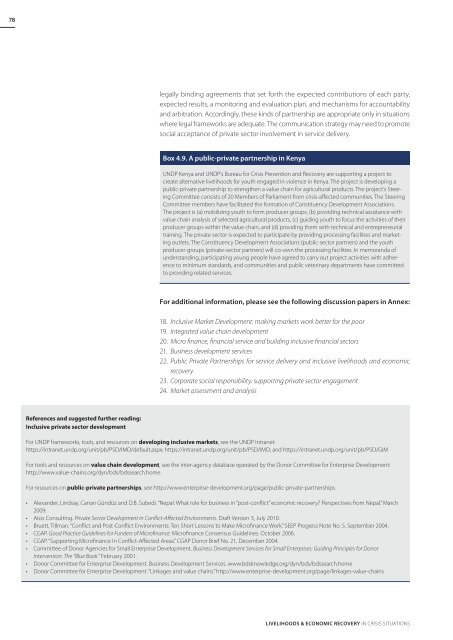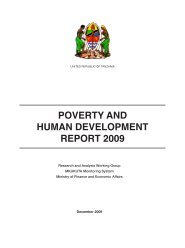Download PDF (4.08 MB) - ReliefWeb
Download PDF (4.08 MB) - ReliefWeb
Download PDF (4.08 MB) - ReliefWeb
You also want an ePaper? Increase the reach of your titles
YUMPU automatically turns print PDFs into web optimized ePapers that Google loves.
78<br />
legally binding agreements that set forth the expected contributions of each party,<br />
expected results, a monitoring and evaluation plan, and mechanisms for accountability<br />
and arbitration. Accordingly, these kinds of partnership are appropriate only in situations<br />
where legal frameworks are adequate. The communication strategy may need to promote<br />
social acceptance of private sector involvement in service delivery.<br />
Box 4.9. A public-private partnership in Kenya<br />
UNDP Kenya and UNDP’s Bureau for Crisis Prevention and Recovery are supporting a project to<br />
create alternative livelihoods for youth engaged in violence in Kenya. The project is developing a<br />
public-private partnership to strengthen a value chain for agricultural products. The project’s Steering<br />
Committee consists of 20 Members of Parliament from crisis-affected communities. The Steering<br />
Committee members have facilitated the formation of Constituency Development Associations.<br />
The project is (a) mobilizing youth to form producer groups, (b) providing technical assistance with<br />
value chain analysis of selected agricultural products, (c) guiding youth to focus the activities of their<br />
producer groups within the value chain, and (d) providing them with technical and entrepreneurial<br />
training. The private sector is expected to participate by providing processing facilities and marketing<br />
outlets. The Constituency Development Associations (public-sector partners) and the youth<br />
producer-groups (private-sector partners) will co-own the processing facilities. In memoranda of<br />
understanding, participating young people have agreed to carry out project activities with adherence<br />
to minimum standards, and communities and public veterinary departments have committed<br />
to providing related services.<br />
For additional information, please see the following discussion papers in Annex:<br />
18. Inclusive Market Development: making markets work better for the poor<br />
19. Integrated value chain development<br />
20. Micro finance, financial service and building inclusive financial sectors<br />
21. Business development services<br />
22. Public Private Partnerships for service delivery and inclusive livelihoods and economic<br />
recovery<br />
23. Corporate social responsibility: supporting private sector engagement<br />
24. Market assessment and analysis<br />
References and suggested further reading:<br />
Inclusive private sector development<br />
For UNDP frameworks, tools, and resources on developing inclusive markets, see the UNDP Intranet:<br />
https://intranet.undp.org/unit/pb/PSD/IMD/default.aspx; https://intranet.undp.org/unit/pb/PSD/IMD; and https://intranet.undp.org/unit/pb/PSD/GIM<br />
For tools and resources on value chain development, see the inter-agency database operated by the Donor Committee for Enterprise Development:<br />
http://www.value-chains.org/dyn/bds/bdssearch.home.<br />
For resources on public-private partnerships, see http://www.enterprise-development.org/page/public-private-partnerships<br />
• Alexander, Lindsay, Canan Gündüz and D.B. Subedi. “Nepal: What role for business in “post-conflict” economic recovery? Perspectives from Nepal.” March<br />
2009.<br />
• Atos Consulting. Private Sector Development in Conflict-Affected Environments. Draft Version 3, July 2010.<br />
• Bruett, Tillman. “Conflict and Post-Conflict Environments: Ten Short Lessons to Make Microfinance Work.” SEEP Progress Note No. 5, September 2004.<br />
• CGAP. Good Practice Guidelines for Funders of Microfinance. Microfinance Consensus Guidelines. October 2006.<br />
• CGAP. “Supporting Microfinance In Conflict-Affected Areas.” CGAP Donor Brief No. 21, December 2004.<br />
• Committee of Donor Agencies for Small Enterprise Development. Business Development Services for Small Enterprises: Guiding Principles for Donor<br />
Intervention: The “Blue Book.” February 2001.<br />
• Donor Committee for Enterprise Development. Business Development Services. www.bdsknowledge.org/dyn/bds/bdssearch.home<br />
• Donor Committee for Enterprise Development. “Linkages and value chains.” http://www.enterprise-development.org/page/linkages-value-chains<br />
Livelihoods & Economic Recovery in Crisis Situations





